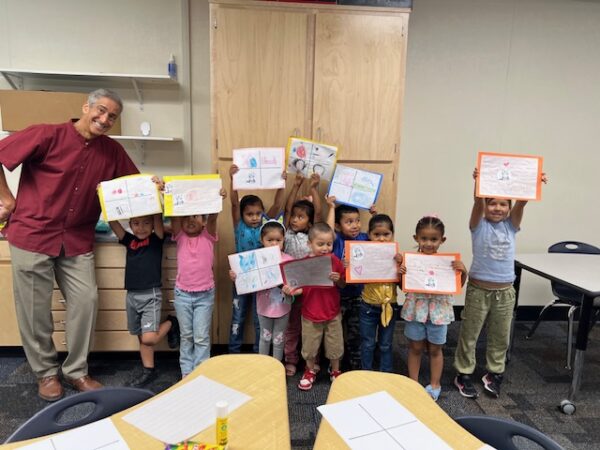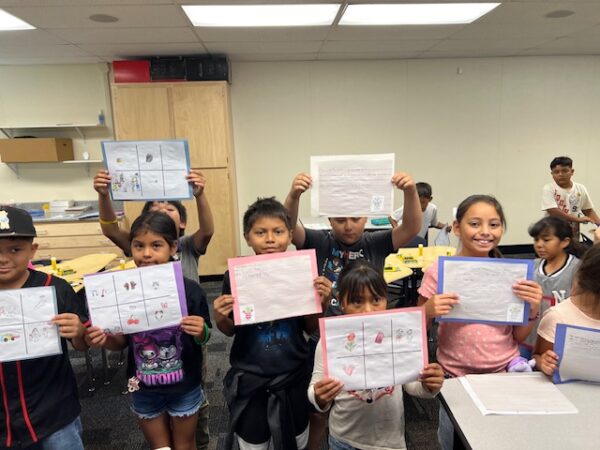Helping kids describe the most interesting thing in the world—their lives!
A Writing and Drawing Workshop Based on “My Favorite Things”
This summer, I had an amazing experience leading writing workshops for Migrant students! I had Pre-K students all the way through 8th grade. So I presented one 60+ minute workshop with each grade level: nine workshops total, three per day. My goal was to get students to draw and describe the “most interesting thing in the world—their lives!”


My three days of workshops were part of a weeks-long Summer Academy for students. Summer school is a chance for Migrant students to make up for lost time during the school year. (Their families move often, following the season’s agricultural work.)
Migrant students vary greatly in language proficiency. While I presented the workshops in English and Spanish, much of the nuanced instruction was in Spanish to accommodate children newly arrived in the U.S. Students had come not just from Mexico but from Guatemala, Honduras and El Salvador! For a few who spoke their indigenous language at home, even communicating in Spanish was a stretch.

My contract from the school district called for “culturally responsive teaching.” So I sought to add elements of music and art to give students less proficient in language more chances for success. Coordinator Jesús Torres was able to round up crayons, colored pencils, blank paper, lined paper, glue sticks, and scissors for use by each class. Thankfully, I was able to conduct all the workshops in the same classroom with air conditioning since the temperatures outside were well over 100°.
Teachers called this inter-disciplinary writing workshop a hit. At the end of each session, students held up their handiwork with pride. And together they moved me with their sensitivity and resilient spirit.


Interested in this multi-media workshop with your students? Read on!
The “My Favorite Things” Writing and Drawing Workshop in 7 steps
1. Introduction and rhythmic warm-up: I briefly introduced myself and some of my published picture books set in different countries. But simply introducing something about yourself, even favorite books, is a good ice breaker. Demonstrating musical connections, I introduced clapping and bongo rhythms to engage students with counting in rhythm. Not a musician? Just put on a few moments of music you like and get the students to count out loud or march in place!
Using slides, I showed them sheet music and explained the time signature 3/4, which means three (3) quarter notes in each measure: One-two-three. Or Un-dos-tres.

2. Singing and studying “My Favorite Things” lyrics for inspiration. I sang the song for them then lead them in singing it, one phrase a time.” (Or let them hear it online: “My Favorite Things” from the Rodgers and Hammerstein musical “The Sound of Music.”) I described Julie Andrews, the famous American actress and singer. I showed slides I had made to help convey the meaning of the song’s rich vocabulary evocative of a different time (1940s) and setting (Austria): “bright copper kettles,” “warm woolen mittens,” “cream colored ponies,” “doorbells and sleigh bells,” etc. Between singing, I explained in Spanish what each stanza meant.

3. Drawing pictures of the students’ favorite things. I had students use the art supplies arranged on their desks to draw pictures of 4-6 important items from their lives: favorite things or items of special significance to them personally. Some students drew a soccer ball, their family car, a picture of their mother, a close relative; backpacks which they brought to school, tacos, videogames, or fruits like oranges and strawberries, which their families helped harvest, etc. Using crayons and colored pencils, they drew their pictures on sheets of blank paper divided into 4-6 squares depending on grade level.

4. Defining their audience, preparing to write: As students drew, I surprised them by appearing in a colorful mask and cape. I explained that I was an alien from the Planet QTX, fleeing magnetic storms at home. As an alien, I came in peace but knew nothing about life on earth. I was therefore relying on the students’ goodwill to explain to me the details of their lives that they’d drawn. (“What’s a taco? What’s soccer? What’s a saxophone? What’s a pet?”) Instead of an alien, I asked the youngest grade students to imagine that they were explaining their themes to a stray kitten that understood words. I asked the older students to explain their items to adolescents from different cultures, say from Asia, Africa or northern Europe.

5. Selecting and writing about one or two favorite things: Writing on lined paper, students described one or two items they had drawn. as if explaining things to an alien (or kitten or peers from other cultures). I asked them to answer a few basic questions like “What is it and what do you do with it?” “When, why, or how?” And, importantly, “How does it make you feel?” I encouraged the students to write in English or Spanish, however they could express themselves best. Teachers and I gave extra support to students who lacked the skills to write in either language. We coaxed them to orally describe details about their theme(s) and, in some cases, wrote for them, taking dictation, then having them read their own words aloud. (Here I discovered what classroom teachers likely know from day one: with some kids, we need to show A LOT of positive interest to get them to make an effort to share.

6. Putting together the artwork and writing. For the final step, the teachers and I distributed pre-cut construction paper, letting each student choose a color they liked. We demonstrated how the students should center and glue their drawings of favorite things on one side of the construction paper. Then they centered and glued their written descriptions on the other. As a finishing touch they glued on a cut-out image of their imaginary audience: a kitten, a space alien, or foreign teens as a reminder of who they were writing for. Students further embellished their projects with colored pencils and crayons with moments remaining. Several groups were so absorbed that, as schedules permitted, they devoted more than the 60 minutes planned.

7. Students pose for pictures, displaying their bright and beautiful creations! Before leaving the room, students also cleaned up and arranged their work stations for the next group. I mentioned to teachers that in the days ahead, students could write about the additional items they’d drawn, again as if explaining their favorite things to audiences totally unfamiliar with their lives.


